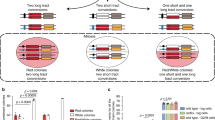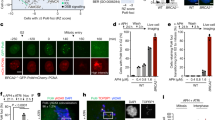Abstract
The checkpoint sliding-clamp complex, Rad9/Rad1/Hus1, plays a critical role during initiation of checkpoint signals in response to DNA damage and replication disruption. We investigated the impact of loss of Rad1 on checkpoint function and on DNA replication in mammalian cells. We show that RAD1 is an essential gene for sustained cell proliferation and that loss of Rad1 causes destabilization of Rad9 and Hus1 and consequently disintegration of the sliding-clamp complex. In Rad1-depleted cells, Atr-dependent Chk1 activation was impaired whereas Atm-mediated Chk2 activation was unaffected, suggesting that the sliding clamp is required primarily in Atr-dependent signal activation. Disruption of sliding-clamp function also caused a major defect in S-phase control. Rad1-depleted cells exhibited an RDS phenotype, indicating that damage-induced S-phase arrest was compromised by Rad1 loss. Furthermore, lack of Rad1 also affected the efficiency of replication recovery from DNA synthesis blockage, resulting in a prolonged S phase. These deficiencies may perpetually generate DNA strand breakage as we have found chromosomal abnormalities in Rad1-depleted cells. We conclude that the Rad9/Rad1/Hus1 complex is essential for Atr-dependent checkpoint signaling, which may play critical roles in the facilitation of DNA replication and in the maintenance of genomic integrity.
This is a preview of subscription content, access via your institution
Access options
Subscribe to this journal
Receive 50 print issues and online access
$259.00 per year
only $5.18 per issue
Buy this article
- Purchase on Springer Link
- Instant access to full article PDF
Prices may be subject to local taxes which are calculated during checkout





Similar content being viewed by others
References
Abraham RT . (2001). Genes Dev., 15, 2177–2196.
Bermudez VP, Lindsey-Boltz LA, Cesare AJ, Maniwa Y, Griffith JD, Hurwitz J and Sancar A . (2003). Proc. Natl. Acad. Sci. USA, 100, 1633–1638.
Boddy MN, Furnari B, Mondesert O and Russell P . (1998). Science, 280, 909–912.
Brondello JM, Boddy MN, Furnari B and Russell P . (1999). Mol. Cell. Biol., 19, 4262–4269.
Bunz F, Dutriaux A, Lengauer C, Waldman T, Zhou S, Brown JP, Sedivy JM, Kinzler KW and Vogelstein B . (1998). Science, 282, 1497–1501.
Caspari T and Carr AM . (1999). Biochimie, 81, 173–181.
Caspari T, Dahlen M, Kanter-Smoler G, Lindsay HD, Hofmann K, Papadimitriou K, Sunnerhagen P and Carr AM . (2000). Mol. Cell. Biol., 20, 1254–1262.
Casper AM, Nghiem P, Arlt MF and Glover TW . (2002). Cell, 111, 779–789.
Chen F, Peterson SR, Story MD and Chen DJ . (1996). Mutat. Res., 362, 9–19.
Cliby WA, Roberts CJ, Cimprich KA, Stringer CM, Lamb JR, Schreiber SL and Friend SH . (1998). EMBO J., 17, 159–169.
Cortez D, Guntuku S, Qin J and Elledge SJ . (2001). Science, 294, 1713–1716.
Edwards RJ, Bentley NJ and Carr AM . (1999). Nat. Cell Biol., 1, 393–398.
Elledge SJ . (1996). Science, 274, 1664–1672.
Feijoo C, Hall-Jackson C, Wu R, Jenkins D, Leitch J, Gilbert DM and Smythe C . (2001). J. Cell Biol., 154, 913–923.
Griffiths DJ, Barbet NC, McCready S, Lehmann AR and Carr AM . (1995). EMBO J., 14, 5812–5823.
Hermeking H, Lengauer C, Polyak K, He TC, Zhang L, Thiagalingam S, Kinzler KW and Vogelstein B . (1997). Mol. Cell, 1, 3–11.
Kaur R, Kostrub CF and Enoch T . (2001). Mol. Cell. Biol., 12, 3744–3758.
Kolodner RD, Putnam CD and Myung K . (2002). Science, 297, 552–557.
Komatsu K, Miyashita T, Hang H, Hopkins KM, Zheng W, Cuddeback S, Yamada M, Lieberman HB and Wang HG . (2000a). Nat. Cell Biol., 2, 1–6.
Komatsu K, Wharton W, Hang H, Wu C, Singh S, Lieberman HB, Pledger WJ and Wang HG . (2000b). Oncogene, 19, 5291–5297.
Kondo T, Wakayama T, Naiki T, Matsumoto K and Sugimoto K . (2001). Science, 294, 867–870.
Lindsay HD, Griffiths DJ, Edwards RJ, Christensen PU, Murray JM, Osman F, Walworth N and Carr AM . (1998). Genes Dev., 12, 382–395.
Lindsey-Boltz LA, Bermudez VP, Hurwitz J and Sancar A . (2001). Proc. Natl. Acad. Sci. USA, 98, 11236–11241.
Lopes M, Cotta-Ramusino C, Pellicioli A, Liberi G, Plevani P, Muzi-Falconi M, Newlon CS and Foiani M . (2001). Nature, 412, 557–561.
Martinho RG, Lindsay HD, Flaggs G, DeMaggio AJ, Hoekstra MF, Carr AM and Bentley NJ . (1998). EMBO J., 17, 7239–7249.
Matsuoka S, Rotman G, Ogawa A, Shiloh Y, Tamai K and Elledge SJ . (2000). Proc. Natl. Acad. Sci. USA, 97, 10389–10394.
Melo JA, Cohen J and Toczyski DP . (2001). Genes Dev., 15, 2809–2821.
Paddison PJ, Caudy AA, Bernstein E, Hannon GJ and Conklin DS . (2002). Genes Dev., 16, 948–958.
Paul CP, Good PD, Winer I and Engelke DR . (2002). Nat. Biotechnol., 20, 505–508.
Post SM, Tomkinson AE and Lee EY . (2003). Nucleic Acids Res., 31, 5568–5575.
Roos-Mattjus P, Hopkins KM, Oestreich AJ, Vroman BT, Johnson KL, Naylor S, Lieberman HB and Karnitz LM . (2003). J. Biol. Chem., 27, 24428–24437.
Rowley R, Subramani S and Young PG . (1992). EMBO J., 11, 1335–1342.
Santocanale C and Diffley JF . (1998). Nature, 395, 615–618.
Sijbers AM, de Laat WL, Ariza RR, Biggerstaff M, Wei YF, Moggs JG, Carter KC, Shell BK, Evans E, de Jong MC, Rademakers S, de Rooij J, Jaspers NG, Hoeijmakers JH and Wood RD . (1996). Cell, 86, 811–822.
Tercero JA and Diffley JF . (2001). Nature, 412, 553–557.
Venclovas C and Thelen MP . (2000). Nucleic Acids Res., 28, 2481–2493.
Volkmer E and Karnitz LM . (1999). J. Biol. Chem., 274, 567–570.
Wang X, Wang L, Callister MD, Putnam JB, Mao L and Li L . (2001). Cancer Res., 61, 7417–7421.
Wang X, Zou L, Zheng H, Wei Q, Elledge SJ and Li L . (2003). Genes Dev., 17, 965–970.
Weiss RS, Kostrub CF, Enoch T and Leder P . (1999). Genomics, 59, 32–39.
Weiss RS, Leder P and Vaziri C . (2003). Mol. Cell. Biol., 23, 791–803.
Weiss RS, Matsuoka S, Elledge SJ and Leder P . (2002). Curr. Biol., 12, 73–77.
Wolkow TD and Enoch T . (2002). Mol. Biol. Cell, 13, 480–492.
Zachos G, Rainey MD and Gillespie DA . (2003). EMBO J., 22, 713–723.
Zhou BB and Elledge SJ . (2000). Nature, 408, 433–439.
Zou L, Cortez D and Elledge SJ . (2002). Genes Dev., 16, 198–208.
Acknowledgements
We thank Howard Lieberman (Columbia University) for antibodies to Rad9 and Hus1 and Robert Weiss (Cornell University) for the Hus1−/−/p21−/− MEF cells. David R Engelke (University of Michigan) kindly provided the pTZU6+1 vector containing a U6 promotor. We also thank Lee Zou (Harvard Medical School) for critical reading of this manuscript and helpful discussions. This work was supported by Public Health Service grants from the National Cancer Institute (CA76172 and CA91029 to LL).
Author information
Authors and Affiliations
Corresponding author
Rights and permissions
About this article
Cite this article
Bao, S., Lu, T., Wang, X. et al. Disruption of the Rad9/Rad1/Hus1 (9–1–1) complex leads to checkpoint signaling and replication defects. Oncogene 23, 5586–5593 (2004). https://doi.org/10.1038/sj.onc.1207753
Received:
Revised:
Accepted:
Published:
Issue Date:
DOI: https://doi.org/10.1038/sj.onc.1207753
Keywords
This article is cited by
-
Rad1 attenuates DNA double-strand breaks and cell cycle arrest in type II alveolar epithelial cells of rats with bronchopulmonary dysplasia
Molecular Medicine (2023)
-
Combined treatment with emodin and a telomerase inhibitor induces significant telomere damage/dysfunction and cell death
Cell Death & Disease (2019)
-
TLK1B mediated phosphorylation of Rad9 regulates its nuclear/cytoplasmic localization and cell cycle checkpoint
BMC Molecular Biology (2016)
-
NF-kappa B mediated Up-regulation of CCCTC-binding factor in pediatric acute lymphoblastic leukemia
Molecular Cancer (2014)
-
The RAD9–RAD1–HUS1 (9.1.1) complex interacts with WRN and is crucial to regulate its response to replication fork stalling
Oncogene (2012)



